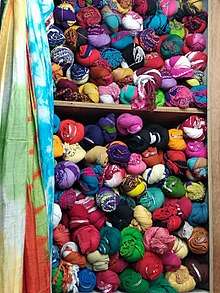Dupatta
.jpg)
Dupatta (Hindi: दुपट्टा, Punjabi: ਦੁਪੱਟਾ/دوپٹا, Urdu: دوپٹا), also Chunari, Chunri (Hindi: चुनरी, Urdu: چنری), Chunni (Punjabi: ਚੁੰਨੀ/چنی), Odhni, Orni, Chādar-odhni, Pacheri, Orna (Bengali: ওড়না) or Unna (Sylheti: উন্না) is a shawl-like scarf and is essential to many women's clothing (usually matched with the garment) from the Indian subcontinent. The dupatta is most commonly used as part of the women's shalwar kameez costume and worn over the kurta and the gharara, but is originally part of the gagra choli outfit. The dupatta has long been a symbol of modesty in dress from the Indian subcontinent as its main purpose is as a veil.[1] In recent times the trend of dupattas for men, worn over the kurta or sherwani, has become commonplace.
History and origin
The word dupatta is a combination of 'du-' meaning two, and 'patta' meaning strip of cloth, originally from Sanskrit.[2] Early evidence of the dupatta can be traced to the Indus valley civilization, where the sculpture of the Priest King whose left shoulder is covered with some kind of a chaddar, suggests that the use of the dupatta dates back to this early Indic culture.[3][4][5] Early Sanskrit literature has a wide vocabulary of terms for the veils and scarfs used by women during ancient period, such as Avagunthana meaning cloak-veil, Uttariya meaning shoulder-veil, Mukha-pata meaning face-veil, Sirovas-tra meaning head-veil.[6] The dupatta is believed to have evolved from the ancient Uttariya.[7][8][9]
Use

Dupatta is worn in many regional styles across the Indian subcontinent. Originally, it was worn as a symbol of modesty. While that symbolism still continues, many today wear it as just a decorative accessory. There is no single way of wearing the dupatta, and as time evolves and fashion modernizes, the style of the dupatta has also evolved.
A dupatta is traditionally worn across both shoulders and around the head. However, the dupatta can be worn like a cape around the entire torso. The material for the dupatta varies according to the suit. There are various modes of wearing dupatta. When not draped over the head in the traditional style, it is usually worn with the middle portion of the dupatta resting on the chest like a garland with the ends thrown over each shoulder. When the dupatta is worn with the shalwar-kameez it is casually allowed to flow down the front and back. In current fashions, the dupatta is frequently draped over one shoulder and even over just the arms. Another recent trend is the short dupatta, which is more a scarf or a stole, often worn with a kurti and Indo-Western clothing. Essentially, the dupatta is often treated as an accessory in current urban fashion.[1]
When entering a mosque, dargah, church, gurdwara or mandir, women cover their head with a dupatta.[10]
Style
.jpg) Bandhani Dupatta
Bandhani Dupatta.jpg) Bangladeshi woman in a different style of draping dupatta
Bangladeshi woman in a different style of draping dupatta.jpg)
 Indian actress Shriya Saran in a modern style of draping dupatta over the neck, while wearing shalwar kameez
Indian actress Shriya Saran in a modern style of draping dupatta over the neck, while wearing shalwar kameez.jpg) Nepali woman in a modern style of draping dupatta over the neck.
Nepali woman in a modern style of draping dupatta over the neck.
References
- 1 2 Mark Magnier (23 February 2010). "For Pakistani women, dupattas are more than a fashion statement". Los Angeles Times.
- ↑ "American Heritage Dictionary Entry: dupatta". www.ahdictionary.com. Houghton Mifflin Harcourt Publishing Company. 2014. Retrieved 2015-05-12.
- ↑ Singh, Upinder (2008). A History of Ancient and Early medieval India : from the Stone Age to the 12th century. New Delhi: Pearson Education. p. 137. ISBN 9788131711200.
- ↑ "Dupatta: a statement of style".
- ↑ Condra, Jill (2008). The Greenwood Encyclopedia of Clothing Through World History. Westport, Connecticut: Greenwood Press. p. 220. ISBN 978-0-313-33662-1.
- ↑ Govind Sadashiv Ghurye (1951) "Indian Costume.", p.236
- ↑ Simmi Jain (2003) "Encyclopaedia of Indian Women Through the Ages: The middle ages.", p.200
- ↑ Anupa Pande(2002) "The Buddhist Cave Paintings Of Bagh", p.49
- ↑ Prachya Pratibha(1978) "Prachya Pratibha, Volume 6", p.121
- ↑ Goldman, Ann; Hain, Richard; Liben, Ann Goldman Richard Hain Stephen (2006). Ox Textbook Palliat Care Child Oxt:ncs C. Oxford University Press. p. 224. ISBN 9780198526537. Retrieved 13 November 2012.
External links
| Wikimedia Commons has media related to Dupatta. |
- "Indian Dupatta From Behind the Veil," an article about the dupatta